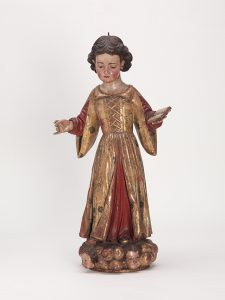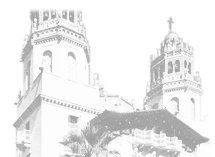
This charming sculpture was created in Spain and likely dates to about 1630-80. The figure represents the Virgin as a young girl, but the seraphim (small heads around the base) refer to her assumption into heaven after her death, while the open book refers to the signal event in her life: it is inscribed with the Archangel Gabriel’s annunciation to her that she would give birth to Jesus Christ. The sculpture is polychromed in estofado, a technique in which most of the sculpture (excluding the flesh) is covered with gold leaf which is then coated with matte tempera paint. Designs incised into the paint reveal the shining gold underneath in patterns that were intended to resemble those of rich brocade fabrics. The Virgin’s outer garment was probably repainted white with flowers in the 18th century. The sculpture is enhanced with perfectly preserved glass eyes, which connote the artist’s skill in incorporating them. William Randolph Hearst bought the sculpture at auction in New York in 1930.


